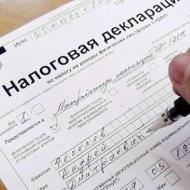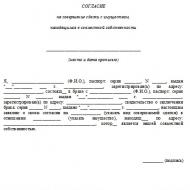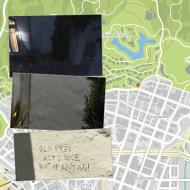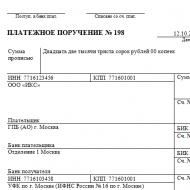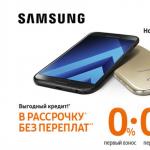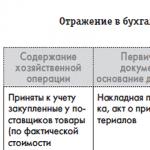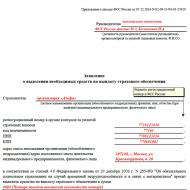
Symbol of the ruble. The history of the origin of the new ruble sign. Two countries, two stories, two different graphic images of the ruble
Sign, symbol of the Ruble: ₽Russian ruble symbol or sign (₽)- a typographic symbol that is included in the group “Currency Symbols” of the Unicode standard and is called “Ruble sign”; code - U+20BD. Mainly used for presentation national currency Russian Federation- ruble. The graphic designation of the ruble in the form of a sign represents the capital letter “P” of the Cyrillic alphabet, supplemented at the bottom with a horizontal line, creating the impression of the presence of two parallel lines, which symbolizes the stable position of the Russian ruble. The symbol can be executed in straight and italic style. It was approved by the Bank of Russia on December 11, 2013. Approval of the ruble symbol is one of the functions of the Bank of Russia in accordance with Article 4 Federal Law"ABOUT Central Bank Russian Federation (Bank of Russia)". More than 61% of participants in a public discussion held from November 5 to December 5, 2013 on the website of the Central Bank of the Russian Federation previously spoke in favor of the ruble symbol approved by the Bank of Russia. Source: 1 - Wikipedia, 2 - Central Bank of the Russian Federation.
Characteristic symbols performing these functions:
R. rub. ₽.
Ruble symbol (font size 96)
₽
Currency code "Russian ruble" ISO 4217 standard
since 1998: RUB and 643
previously: RUR and 810
Ruble symbol on keyboardAt the time of adoption, the symbol had been in unofficial use for many years, but it was not in Unicode: the consortium was waiting for the official adoption of the symbol. On January 21, 2014, the Russian Technical Committee for Standardization " Information Technology(TK22), which is the Russian national working body of ISO/IEC STK1, an application has been submitted to the Unicode Technical Committee to add the ruble symbol - 20BD16 Ruble Sign (₽) - to the Unicode character set. On February 4, 2014, at the 138th meeting of the Unicode Technical Committee in San Jose, based on this application, it was decided to include the ruble symbol in the Unicode version 7.0 standard, and this symbol appeared in Unicode 7.0, released on June 16, 2014.
On August 13, 2014, Microsoft released an update to the MS Windows OS, which makes it possible to enter a new ruble symbol from the computer keyboard. In most cases, this requires entering the combination on the Russian keyboard on keyboard: Right Alt + 8. Other options are listed on the update description page. The described scheme assumes that the current font contains the ruble symbol in a standard place; Microsoft has already adjusted its font library in one of the previous Windows updates. The display of the ruble symbol depends on the versions of the font files installed on the user’s personal computer. Even if the fonts on the server contain it, the external user may have a version without the symbol and will not be displayed, or a glyph from another font will be displayed. For example, you can try to enter a character in Word using the combination Right Alt + 8.
Russian ruble symbol codes
Name:
HTML code:
Description of the approval process
From November 5 to December 5, 2013, the Bank of Russia conducted an anonymous survey on its website: Internet users who declared that they were over 18 years old could choose one of five characters, vote against all of them and comment on their choice in five hundred characters, including spaces. According to the survey results, almost 280 thousand clicks were recorded, which were distributed as follows:first place - more than 61%;
second place - about 19%;
third place - 5.5%;
fourth place - 4.5%;
fifth place - 1.9%;
against all - less than 8%.
However, the leading options have not been named. Since the survey was anonymous and did not even require registration on the website, the Bank of Russia did not explain the methodology for taking into account repeat votes and, accordingly, the meaning of the percentage distribution of clicks between unknown candidate signs. In general, you can understand the preferences of the Internet audience based on the open results of parallel voting that took place on several other sites using the same signs, for example, on the sites of the Prime agency or Russian newspaper. The design sign was in the lead - “P” with a crossed out leg.
Even on the first day of the survey, one of the Bank of Russia employees, in a conversation with a correspondent of the Izvestia newspaper, said that “for the regulator, this is not so much a vote as a collection of opinions and comments... Votes without text comments regarding the choice made will not be taken into account... The purpose of the discussion is to identify some nuances, for example, whether these symbols do not offend someone’s religious feelings, whether they have racial overtones and whether they are already used in some other capacity.” The Bank of Russia began publishing some selected comments on November 18. As the bank's press service reported, these comments are “typical opinions about each of the five proposed symbols.”
The composition of the working group that prepared candidates for voting: full list the criteria for including symbols in the shortlist, the criteria, timing and procedure for the final selection of the ruble symbol were not indicated on the website of the Central Bank of the Russian Federation. The channels for collecting opinions from Russian citizens who do not use the Internet, which is more than half of the country’s adult population, are not described in any way. Based on the results of the survey, the Bank of Russia announced that it would “carefully analyze all reviews left on the site and take them into account when making a decision,” but the timing of this decision was not specified.
As noted on the bank’s website, “a working group of the Bank of Russia considered more than a thousand requests from citizens and organizations with proposals for various spellings of the graphic symbol of the ruble, and studied the ideas of the Internet community. Among them, the five most frequently proposed options were selected.” Meanwhile, many domestic media outlets note the obvious absence of symbols based on the Latin letter “R” in the shortlist, in particular, symbols that won in some competitions, the authors of which were Tagir Safaev (crossed out “R”) and Vladimir Efimov (“R” with double diagonal leg). So, in 2006, the All-Russian Center for the Study of Public Opinion and the newspaper Izvestia asked experts to select 13 of the most interesting signs, which VTsIOM then presented to Muscovites in four focus groups, finding that 4 signs left Muscovites indifferent, 3 were considered inappropriate, 4 - "ambivalent". Only two signs aroused interest among respondents - namely, the projects of Safaev and Efimov based on the Latin alphabet. The results of the study were presented on June 14 at the round table “What should the sign of the ruble be?”
On December 11, 2013, the ruble symbol was officially approved by the board of directors of the Central Bank of the Russian Federation. The winner was the letter “P” with a horizontal line, which received more than 61% of the votes.
Signs used in the survey of the Central Bank of the Russian Federation
Ruble symbol on coins and stamps
Such coins were released into circulation on June 17, 2014: commemorative silver coins with a face value of 3 rubles, as well as steel coins with nickel galvanic coating with a face value of 1 ruble. Silver coins are issued in a limited edition: 500 pieces with proof quality, 1000 pieces with uncirculated quality. Coins in denominations of 1 ruble are issued as part of an emission program with a circulation of 100 million pieces. Description of the coin on this
There are times when you need to use characters that are not on the keyboard. For example, all sorts of crosses, stars and hearts in statuses or nicknames in in social networks, such as VKontakte or Facebook. This article describes in detail how to type such characters.
And so, just below you will see two ways, the first is to type such characters on a computer using codes with the Alt key, and the second way to type on an Android tablet or smartphone, which is also necessary. And just below you will learn how to type the ruble sign on the keyboard.
A set of symbols and signs on the keyboard.
There is such a wonderful key - "Alt". It is often used, for example, when using keyboard shortcuts in other programs, such as . But today we need it for other cases, namely, for typing various symbols and signs that are not on the keyboard. Below you will see a list of codes and opposite symbols. You just need to hold down the Alt key and on the right side of the keyboard type the code that corresponds to the character you need.
If these buttons do not work, then you need to turn on the NumPad, to do this you need to press the Num Lock key, otherwise the NumPad buttons will work as controls for you.
As you can see, everything is simple.
Character codes with Alt key. So, how do you enter characters on the keyboard with the Alt key? Everything is much simpler than it seems. In order to enter a character, you need to hold down the Alt key and type numbers on the NumPad.

After which you can omit the Alt key, but the main question arises: what numbers should you enter to get the desired character? This is where the list of Alt character codes below will come to your aid. The list is considerable; it contains various symbols from hearts and crosses to zodiac signs.
Alt symbol table:




How to type the ruble symbol on the keyboard?

If you need a ruble sign, then you probably already noticed that it is not found anywhere on the keys, let's figure out how to enter the ruble sign.
In Windows 10, 8.1, 8 and Windows 7, you can also type the ruble sign using the Alt key. To do this you need to press and hold right Alt + 8. If you can’t type the ruble sign in Windows 7, then the update may not be installed, just update the system through Windows Update.
Also, you can simply copy the ruble sign here - ?.
Symbols of the zodiac signs.
You can simply select these symbols of the zodiac signs, copy (Ctrl+C) and paste (Ctrl+V) to the desired place, either from a computer or from a mobile device.
Twins.
Scorpion.
Sagittarius.
Capricorn.
Aquarius.
Character set on an Android device.
If you are using a tablet or smartphone on Android, then it is even easier to enter characters here, because you do not need to use any codes. The default keyboard (usually the Google keyboard) is of course good and convenient, but there is a more universal analogue “Hackers Keyboard”. This keyboard has many characters that can be entered without codes. This keyboard is completely free and is available on the Play Market.
Now you can type characters that are not on the keyboard, thanks to the Alt character table, you also learned how to type the ruble sign and enter symbols on an Android device. That's all, if you have any questions or have anything to add, please comment.
Symbol (sign) of the ruble- an abbreviation of the word “ruble” that arose as a result of the evolution of Russian writing, which was used from the second half of the 17th century to the second half of the 19th century century and was a ligature, a natural combination for cursive writing of the superscript letters “p” and “u”. Over time, this ligature lost its original meaning and by the end of the 18th century it turned into an independent symbol, adjacent to modern letters.
The priority for the discovery of the sign belongs to the Minsk historian Ivan Sinchuk. The priority of the first scientific interpretation of the sign belongs to Ekaterina Vorobyova.
Currently, two designs are used as unofficial symbols of the ruble: the lowercase letter “r” with a dot (“r.”), as well as the so-called “Lebedev-Tarbeev sign” (the letter “R” with a crossed out leg).
In accordance with clause 2.1 of Art. 4 of the Law “On the Central Bank of the Russian Federation (Bank of Russia)” (86-FZ dated July 10, 2002), it is the Bank of Russia that “approves the graphic designation of the ruble in the form of a sign.” As of December 1, 2012, the ruble symbol has not been approved.
XVII-XIX centuries
Timeline and examples of use
One of the first precisely dated examples of the use of the ruble sign is contained in the Collection of Translations of Epiphany Slavinetsky. It is found in the so-called sales note (an inscription in the margin of a book indicating the fact of ownership, purchase or sale of the book), which reads: “On the 5th day of December 1681, the Belakhonian Vasily Ivanov, son of the Tveritinov, sold this book, spoken by heaven, to the town dweller Terentyev, son of Michnik. And I, Vasily, took the book for 12 rubles 100 altyn 2 money. And I, Vasily, signed it with my own hand. I sold it clean and truly and had a hand in it”.
The latest known example of the use of the ruble sign dates back to the first half of the 19th century. It appears in the entry on the flyleaf of the Code of Law of the Sovereign Tsar and Grand Duke Ivan Vasilyevich, which reads: “4 rubles, December 18, 1830”. The recording was made by academician Pavel Stroev, one of the first collectors of ancient Russian written monuments, on a book that was part of his personal library.
There are examples of the use of the ruble sign not only in personal and business correspondence, but also in official documents, for example, in the inventory of things and money seized from the Decembrists during the arrest (GA RF, f. 48).
From a letter from Ivan Sinchuk to the editors of the magazine “Money” dated November 11, 1999.
Historical documents allow us to conclude that by the beginning of the 19th century, the ruble symbol was familiar and actively used by representatives of many classes Russian Empire: army and court scribes (philistines), booksellers (merchants), university professors (commoners), nobles. For example, a document addressed to the poet Vasily Zhukovsky is known.
I came across a ruble sign similar to that presented in the affairs of the Decembrists in letters from Moscow University professor Mikhail Kachenovsky to Vasily Zhukovsky, in which they discuss financial questions related to the publication of the journal “Bulletin of Europe”. The first letter is dated January 3, 1812, the second - February 23, 1814. The sign is also found in Kachenovsky’s letter to Kazan University professor Perevoshchikov, which talks about sending books for sale. The letter is dated September 18, 1817. From a letter from Yuri Evdoshenko to the editors of Dengi magazine
The end of the use of the ruble sign dates back to the middle of the 19th century.
Since the sign is found in letters, reports, and inventories, we can conclude that it is widely used both in official documents and in everyday correspondence. This is confirmed by other “cases” of the 48th fund. For example, “The case of things and money that belonged to Batenkov” (No. 296), “The case of the sale at auction of things that belong to no one knows who, and the criminals Yushevsky and Shchepin-Rostovsky due to inconvenience in correspondence” (No. 297), the case “At the request of arrested persons about the release of their own money to buy tobacco and for other needs" (No. 298), "The case of government claims opened against former regimental commanders and other officers involved in the case of a secret society" (No. 300) ... But in In documents of a later period, the “ruble sign” is no longer found. In any case, I did not find it in other documents randomly ordered from the Civil Code of the Russian Federation dating back to the mid-19th century (in the first and second inventories of the 95th fund “Investigative Commission of 1862. Material evidence”, in case No. 245 “On vacation money to the St. Petersburg and Moscow commissions, at the request of Count M.N. Muravyov and about the expenses thereof" and in case No. 6 "Accounts of Dostoevsky M.M. and E., cash receipts and bank statements"). Pavel Timashkov specially for Dengi magazine
It should also be noted that there was experience in using the ruble sign in printing - in particular, in Magnitsky’s “Arithmetic” (1703), but this experience was not widespread.
Historical outline of the ruble symbol

Act of redistribution of copper into coins (XVIII century)
According to the classical version, which Ekaterina Vorobyova adheres to in her works, in the letter combination “ru”, which became the basis of the independent sign of the ruble, the letter “r” (“rtsy”) is rotated 90° counterclockwise, and the letter “u” (“uk” ) is written over it. Another point of view is shared by Ivan Sinchuk, who believes that the letter “p” rotates 90° counterclockwise, and the letter “u” written on top of it rotates 90° clockwise. Both versions are confirmed in the primary sources: the specific outline of the sign strongly depends on the characteristics of the handwriting and varies from a clear reproduction of one of the options described above to a regular cross.

The use of cursive letter combinations of the 16th-17th centuries is a common phenomenon in the practice of scribes of the 18th-19th centuries. Just as often as the letter combination “ru”, a ligature of the superscript letters “m” and “u” was used. For example, it appears several times in the Determination on the reorganization of the Academic University, compiled by Mikhail Lomonosov and recorded by a scribe on February 14, 1760, and is used as the end of ordinal numbers in the dative case: “1 mu professor of general rights, 2 mu Russian rights, 3 mu history and politics." Like the ruble symbol, the “mu” ligature, which originally appeared as a combination of superscript letters, is written in a superscript (superscript) to the right of the numbers.
In the 17th century, the ligature “ru”, being a letter combination itself, was written above the numbers in accordance with the rules of cursive writing. At the same time, Cyrillic letters were then used as numbers, over which the title was written. In case of sums of money the title was replaced by the cursive ligature “ru”.
IN early XVIII century, Cyrillic letters and numbers are replaced by Arabic numbers, and the need to use titlos disappears. From this moment on, the ligature “ru” begins to shift in relation to the numbers to the right and down, losing its original meaning as a letter combination and turning into a full-fledged symbol, an independent grapheme.
In the 19th century, having become a sign, the ligature “ru” was significantly reduced in size and written to the right of the numbers above the main line - just as ordinal numbers are now written using numbers in English language, that is, using a superscript, or superscript (1 st, 2 nd, etc.). In Russian, when handwritten, such an index is usually underlined by one or two lines (1 th , 2 th etc.). But in the case of monetary amounts, the horizontal “p” often replaces such lines.
Thus, replacing first the title, and then a single or double underscore, the horizontal “p” in the ligature-sign “ru” was greatly simplified to a straight or wavy horizontal line. As a result, the classic cursive ligature in the form of a horizontal “r” and a vertical “u” written on top of it began to resemble a shortened letter “u” crossed out below the middle.
Modern interpretations of the ruble symbol

The only attempt to scientifically systematize variants of the ruble sign on very limited material (documents of 1820-1830 from the National Historical Archive of Belarus in Grodno) was made by Ivan Sinchuk in his work “The Many Faces of the Ruble Sign”.
The only professional attempt to link the historical sign of the ruble to the main typefaces of modern fonts in 1998 was made by the art director of the ParaType company Vladimir Efimov.
The only attempt to create a modern logo based on the sign of the 17th-19th centuries was made in 2005 by journalists and artists of the magazine “Everything is clear” (repeated in 2009 in the magazine “Idea X”).
A variant of writing the sign in one stroke was proposed in 1999 by Yuri Kalashnov.
Symbols of other denominations and units of account
A comparative analysis of documents of the 18th century and documents of the 19th century allows us to assume (for now this is just an assumption that requires additional study) that other denominations also had their own symbols Russian money, in particular, in kopecks, money and altyn.
Having originated as superscript letter combinations typical for cursive writing (“de” - money; “ko” - kopek) or simply letters (“a” - altyn), the quasi-symbols of these denominations retained their basic cursive features until the first half of the 19th century, violating the already established time reduction rules. So “money” should already be abbreviated as “den.” or “d.”, and kopek - like “kop.” or to.". But like the ruble symbol, they only shifted relative to the number to the right and slightly down, supplemented by a single or double underline (kopeck - co, money - de, altyn - a).
The end of the use of these symbols, as well as the ruble symbol, dates back to the middle of the 19th century.
| Period | Ruble | Hryvnia | Altyn | Money | Kopek |
|---|---|---|---|---|---|
| Cursive writing of the 17th-18th centuries. | no rice | no rice | |||
| Cursive writing of the first half of the 19th century. | no rice | no rice | |||
| Magnitsky's Arithmetic (1703) | no rice | ||||
| Modern styles | No | No | No |
Drawings of ligatures of the ruble symbol and the kopeck symbol
| Ruble symbol | Penny symbol |
|---|---|
 |
 |
The ligatures are based on the work of Ivan Sinchuk “The Many Faces of the Ruble Sign”, prepared on the basis of documents of 1820-1830 from the National Historical Archive of Belarus in Grodno.
XX-XXI centuries
Chronicle
With the start of integration Russian economy in the world (90s of the XX century) and widespread use in domestic Russian circulation foreign currencies(primarily the dollar, which has its own recognizable sign), proposals have been repeatedly made to introduce a sign for the Russian ruble. With the advent of the euro and the approval of its sign, such proposals began to be heard more often and resulted in several unofficial competitions, promotions and initiatives to introduce the ruble sign.
The first known one is the competition, which was held in 1997 by the magazine “Financier” and which received about 300 works (the author of the idea was Andrey Eremenko).

Finalists of the “Ruble Sign” campaign
The second in time was the “Sign of the Ruble” campaign, which was held in 1999-2000. carried out by the magazine “Money” and the Club of Graphic Designers “Portfolio” (the authors of the idea were Yuri Kalashnov and Pyotr Bankov). 300 authors took part in it, proposing a total of about 1000 options for the design of the ruble sign. Important feature this action was that during it for the first time in modern history Evidence of the existence of a ruble sign from the 17th to 19th centuries was found. At the same time, about 1000 people were surveyed and asked the question “Does the Russian ruble need a symbol similar to the signs of the dollar, euro, pound sterling and other currencies?” Over 85% of respondents responded positively. When asked whether contemporaries are ready to consider the combination of superscript letters “p” and “u” as a ruble sign now, the following result was obtained: 73% - “for”, 23% - “against”.
The third was the competition “Draw the symbol of the ruble!”, held by the newspaper “Komsomolskaya Pravda” in 2005-2006. The competition became the most widespread in terms of the number of applications submitted: the editors received more than 5,000 sketches.
The fourth competition is “Create a ruble sign”, held by RIA Novosti in 2006. The organizers received about 300 proposals, and the best ones were sent to central bank and the State Duma.
It is also necessary to note the huge number of individual initiatives that were expressed in direct letters to various government bodies (primarily the State Duma and the Central Bank of the Russian Federation) and even registration of images of the ruble sign in the Russian Society of Authors.
In addition to competitions and promotions, a study conducted in 2006 by the All-Russian Center for the Study of Public Opinion (VTsIOM) and the newspaper Izvestia deserves attention. On May 25, the newspaper published 13 signs, which were pre-selected by experts interviewed by Izvestia. VTsIOM presented them to Muscovites in four focus groups and found that 4 signs left Muscovites indifferent, 3 were considered inappropriate, 4 were considered “ambivalent”. Only two signs aroused interest among respondents. These are projects by Tagir Safaev (Latin “R” with two horizontal lines at the top of the vertical leg) and Vladimir Efimov (Latin “R” with a double diagonal leg). The results of the study were presented on June 14 at the round table “What should the sign of the ruble be?”
Later, the Bank of Russia working group on approving the ruble symbol held several more meetings, but no official press releases were issued based on the results of its work, so the topic easily became the object of various speculations. Here is just one typical example:
As reported news agency“Jeans” source, who took part in the work of the Central Bank commission, the new sign of the ruble will be officially approved after some time, but the final decision on how it will look has already been made. The new ruble sign will look like this: P. That is, it will be a capital Russian letter “P” with a dot. The sign is placed with a space after the digital indication of the amount (for example: 100 RUR), the source said. According to him, this sign was approved mainly for the following reasons:
- such a designation is intuitively clear to any Russian;
- the Russian “P” can be written even in the absence of a Cyrillic font, replacing it with a similar-looking Latin letter “P”;
- Everyone will be able to use this sign immediately after approval - there will be no need to enter it into international standards some additional symbol, wait a long time for it to appear on keyboards and spend huge amounts of money on the implementation of this symbol.
It is also believed that the Central Bank considers the abbreviation “RR” as a symbol of the ruble, which is one of the tools for protecting Russian paper money from a counterfeit and is visible on the strip under the design on the obverse of the banknote when viewing it at an acute angle in reflected light (kipp effect). The basis for this conclusion was a letter received by the organizing committee of the “Sign of the Ruble” campaign from the Department of External and Public Relations of the Central Bank of the Russian Federation in response to an invitation to delegate a bank representative to the jury of the competition.
In mid-2007, the design studios “Design Depot”, “Designet”, “Direct Design”, “Imadesign”, “Letterhead”, ParaType and Artemy Lebedev Studio proposed using the letter “P” with a leg crossed out below the semicircle as a sign for the ruble .
To select the “Ruble Sign” symbol, we used objective criteria that are important for its effective use:
- Simplicity of graphics;
- Difference from other writing characters adopted in the main font systems, primarily in Cyrillic and Latin;
- Intuitive clarity for a representative of Russian-speaking culture. The sign is introduced primarily into domestic circulation, so it is more important that it is correctly perceived by Russians than by foreigners;
- Convenience of writing by hand (among other things, motor memorization is the fastest and most reliable);
- Single-composition. A character consisting of one grapheme is faster to read and usually takes up less space. A one-part, non-ligature sign is easier to integrate into a table set, which is extremely important in in this case;
- Font independence. A symbol, a grapheme, is introduced into everyday use, and not a sign of a specific font. This grapheme should be able to be stylized into any typeface of an existing or future font when supplemented with a ruble sign;
- Uniform density. The absence of areas overloaded with strokes, too small, unnecessary strokes. These parameters become crucial in a small-sized set. The character should not appear in the fourth point of the text font;
- The width is no greater than zero (the widest digit). An important parameter: in typesetting fonts, the widths of currency symbols must correspond to the widths of numbers to simplify table typesetting;
- Understandable to a foreigner familiar with the Latin alphabet;
- The presence of slight unusualness within the normal range, facilitating memory and recognition.
From the manifesto of design studios
Nowadays, everyone knows what the ruble symbol looks like. You can see the symbol of this currency in the article. In it we will talk not only about its history. We will also tell you how to enter the ruble symbol in the text input field. Of course, it is not specified, but there are still ways to enter it. In this article we will look at them all.
History of the symbol
Initially, of course, it is worth paying attention to the history of the symbol. How currency appeared back in the thirteenth century. And almost immediately there was a need to reduce it. There were a lot of variations, but the first known variant that became known to us was a combination of two letters - “r” and “y”. One thing can be said for sure: this abbreviation appeared as a result of the evolution of the then written language in Russian. By the way, this abbreviation originated in the 17th century and was used until the 19th.
Nowadays, another symbol for the ruble is the symbol “₽”. However, it is worth noting that this spelling option is relevant only for banknotes of Russian origin, and everyone knows that the ruble is used in three countries: Russia, Belarus and the unrecognized Transnistria. It is different for each country.
- in Belarus - "Br";
- in Transnistria - “P” with a line that is located vertically.
But in this article we will only talk about Russian ruble.
Keyboard paste
So, we have already done the main thing, we have indicated the designation of the ruble. We know the symbol, and now it’s time to tell you how to enter it from the keyboard. The first method that we will use appeared relatively recently, in 2013. But it is worth noting that Microsoft has not implemented this symbol in all of its operating systems, but only in the current ones.
So, continuing to talk about the designation of the ruble, you will not find the symbol on the keyboard, as mentioned above. Here you will need to use the keyboard shortcut - Alt + 8.
Everything is quite simple, after pressing these two keys, the ruble symbol will be printed in the place where you placed the cursor. But it’s worth making a note that you need to hold down Alt right, not left, and enter eight on the top numeric keypad, otherwise nothing will work.
Inserting using a symbol table
Above was presented the simplest way entering the ruble symbol. But for some reason it may not work (a broken key or an outdated version of Windows). What to do if you urgently need to enter the ruble symbol? The symbol in Word will help you with this. So, now we’ll look at a way to insert a ruble symbol into a document using a symbol table in Word.
This is done quite simply; the main thing for you is to initially open the table itself. To do this, go to the "Insert" tab. Now on the toolbar you need to find the “Symbol” button. Click on it and select "Other symbols" from the drop-down menu. You can visually observe the entire process in the picture below.

Now you have the table you need. As you can see, there are an unimaginable number of symbols; manually searching for the one you need will take a long time. To make your search easier, you can select " from the "Set" drop-down list " Currency". After this, they will appear in front of you different countries. Find the one you need and click the "Insert" button. Pay attention to the sign code, this will come in handy later.
Using hexadecimal code
Remember that code you needed to pay attention to? This is the hexadecimal code of this character. Now let's look at how it should be used to enter the ruble symbol.
And there’s practically nothing to do here, you just need to enter the code and press ALT + X. But for greater clarity, let’s look at everything with an example.
Let's say you entered a number in Word and want to put a ruble symbol at the end. For this:
- place the cursor in the desired place;
- enter "20BD";
- Press the keyboard shortcut ALT+X.

After this, the code will turn into the symbol we need. If you want to find out other symbol codes, then you can view them in the table with symbols, simply highlighting the desired element. The "Character Code" field will display a set of four characters, which is the hexadecimal code of the selected character.
Using the clipboard
Well, the last method is generally for the lazy, although few people know about it. Using it, you can insert not only a printed symbol into a document, but also the picture of this symbol itself. To do this, the picture or symbol must initially be placed on the clipboard, that is, simply copied. When the desired object is in the buffer, make sure that you do not copy something else there, otherwise it will not work.
After that, open the program or page where you will enter the symbol, paste the copied object using the CTRL + V combination or the context menu.

By the way, you can use this article to copy the necessary material. Here is the symbol itself - “₽”. By the way, you can copy any symbol or image in this way.
Alexander Igorevich
Reading time: ~5 minutes
Many of the world's major currencies listed on foreign exchange market, have their own symbol (ligature) used for abbreviation. The US dollar has it - this is the well-known “$”, the Japanese yen - “¥”, the oldest pound sterling - “£” and even the youngest currency - the euro, also has its own short symbol - “€”, which it acquired in as a result of painful elections and torment that ended in December 1996.
But one of the most stable currencies in the world has Swiss franc there is still no own ligature, and the Chinese yuan did not act entirely correctly, appropriating the designation of the Japanese yen - it turns out that this happens.
In Russia, the idea of creating its own currency designation has been in the air for a long time, but only at the beginning of December 2013 was a new ruble sign finally chosen.
Attempts to begin developing a short notation Russian currency were undertaken back in 1997, after the denomination. Several variants related to the Latin letter “R” were developed, but a default occurred and the matter stopped. In 1997, the competition was held by the magazine “Financier”, the result was 300 writing options, but none of them were approved.
The second similar competition was held in 1999 by the Dengi magazine, followed by 2 more competitions - from the Komsomolskaya Pravda newspaper, held in 2005-2006, and from RIA Novosti.
The now winning symbol was developed in 2007 by an initiative group created by the famous designer Erken Kagarov, which included Designet, DesignDepot, Imadesign and other companies.
Criteria that the ruble symbol must meet
When choosing the most interesting and suitable options The compliance of the ligature with the following requirements was taken into account:
- Graphic uniqueness and originality of the sign,
- Ease of writing, memorization, perception and reproduction of the symbol,
- Convenient handwriting
- A solid, persistent and unambiguous association with the Russian currency,
- Absence of clear associations with any religion,
- Preservation of graphic standards and style of writing signs of other world currencies,
- Single-part designation is important for simplicity and ease of use (for example, the letters “yu” or “s” are two-part),
- The character width must be standard - this is an important parameter for typesetting fonts,
- Font independence - the ligature should easily fit into both Cyrillic and Latin fonts, and into any
- Uniform density - means the absence of graphic overloads and too small details in one of the parts of the symbol,
- The Russian currency designation has historical and cultural roots.
This is only part of the objective requirements - there are also subjective ones, such as speed and ease of identification, harmonious perception of the logo among the designations of other currencies, the absence of negative, ambiguous or dubious associations, and others.
Why do we need a Russian currency symbol?
Many people wonder: “ Why do we even need this logo for our currency?" After all, we lived without it for almost five centuries - since the time of the ruble reform of Elena Glinskaya, the famous mother of Ivan the Terrible.
According to the Central Bank, in other leading countries of the world, currency designations began to appear with the involvement of national currencies in international turnover. Thus, the symbols that appeared received recognition on the world stage. So having your own sign will contribute to the recognition of the Russian currency throughout the world and its recognition.
E. Nabiullina believes that the graphic image emphasizes the stability of the ruble.
As Nikolai Zhuravlev said, “the sign of the national currency, its presence is international practice, now the Russian ruble has ceased to be an exception to the rule in this sense.” He also answered the question of what the presence of a currency logo gives the country: “the official approval of the symbol of the Russian currency will increase its authority in the world market and will become the basis for the unification of the graphic designation.”
According to Alexander Troshin, First Deputy Chairman of the Federation Council, the appearance of currency symbols on keyboard layouts will help promote the logo throughout the world.
Other interesting facts about the new ruble sign
- In 2014, the issue of coins in the denomination of “1 ruble” with the image of the approved designation will be organized. The circulation will be 100 million copies. The coins will be minted throughout 2014 from steel with a nickel plated plating.
- In addition, the approved ligature will be used in the packaging of banknotes and in their security symbols.


